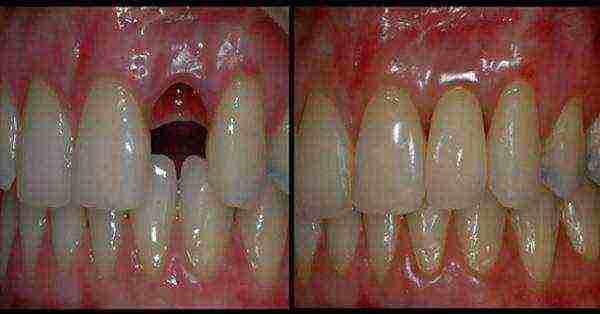Japanese scientists made a gift to dentists and their patients, thinking about the perfect replacement of prostheses and implants. Stem cell experiment means you don't have to worry about lost teeth anymore
Scientists have learned to grow teeth right in the patient's mouth. A successful experiment has so far been carried out only on laboratory mice, but the prospect of operations of this kind for humans is not far off.
Scientists from the Tokyo Scientific University of Noda under the guidance of Professor Takashi Tsuji became the authors of the new technique in dental treatment. Their research initially focused on the behavior of the germ cells from which teeth are formed in the mouse.
After extracting such cells from mouse embryos, scientists divided them into two types - epithelial cells and mesenchymal cells. From the first type in the body, glands are formed, the surface of the mucous membrane. The second group is responsible for the presence of connective tissue and muscles. After separation, the cells were reconnected to obtain embryonic dental tissue.
The resulting tissue was grown for several days in a special nutrient medium, and then transplanted to animals in the place of previously removed molars. After almost a month, new teeth appeared at the transplant site, and after another two weeks they were fully formed for normal functioning. The color, size and position of the new teeth were no different from the old ones.
Professor Tsuji explained how the new method will work in humans: "In humans, you can use reprogrammed stem cells instead of germ cells, which can be rearranged and then used to create embryonic tissue for growing teeth." Scientists say that the development and elimination of all the shortcomings of this technology will take about five years. This means that in the near future it will be possible to completely abandon implants and dentures.
Anyone who has had a dental nerve removed at least once will be very pleased with this news. The most excruciating pain will soon be over. New animal trials by researchers from South Korea, Japan, the United States and the United Kingdom have shown that stem cell procedures can help restore the vital living tissue of the tooth, the pulp. The process is still in its early stages of development, but if successful, it could mean reducing or even eliminating the need for painful dental nerve removal.
“The whole concept of pulp regeneration is to try to keep the tooth alive ... This means that the natural defense mechanisms of the tooth will be preserved,” says Tony Smith, an oral biologist and professor at the University of Birmingham (UK).
A five-day-old tooth embryo was placed in the gum (top), erupted after 36 days (middle) and fully grown after 49 days (bottom).
Some scientists have focused on growing completely new teeth. Most try to grow new, healthy pulp within the hard enamel of tooth enamel, either by stimulating stem cell growth or by better controlling inflammation caused by infection.
Pulp regeneration is carried out using a hydrogel containing a small protein. The gelatinous substance is injected into the tooth and serves as the base on which the cells, blood vessels and nerves of the pulp grow.
Another approach is to extract the pulp from the tooth and isolate the stem cells, and then transplant the stem cells with the molecules that stimulate their growth back into the tooth cavity. Human clinical trials of the hydrogel method will begin no later than two to three years, and it will be used in dental treatment in five years.
FROM THE DOSSIER "KP"
Sensational experiments are underway in Japan
In 2009, the Internet and newspapers around the world were full of screaming headlines two years ago: scientists have grown a full-fledged tooth in a mouse in place of a torn one! Professor Takashi Tsuji of the University of Life Sciences of Tokyo studied the behavior of the germ cells that form teeth in the mouse and came up with a way to stimulate their growth. Then he managed to carry out an operation in the mouth of a rodent. And he soon clicked with an artificially grown fang. And in 2011, the scientist improved and accelerated the process.
Now the teeth are grown like this. From the embryos of mice, 40-50 thousand stem "tooth" cells are extracted, they are grown for some time not in the mouth, but in a special composition - jelly-like collagen. Then, when a tooth embryo about half a millimeter in size grows, it is transplanted into an adult mouse in place of the torn cutter. After 37 days, the tooth breaks through the gum. And after 49 days, the new cutter is no different from the old one. The "beginner" has the same strong enamel, it is also firmly attached to the jaw, while maintaining natural sensitivity: nerves and blood vessels grow inside the tooth. New teeth do a great job with any mouse food.
Grow new teeth, even in 3 rows, soon everyone will be able to! Professor Jeremy Mao from Columbia University has proposed a revolutionary new technology that will allow you to forget about drills, implants, dentures and other dental joys.
The problem is that the installation of implants requires repeated visits to the doctor and is often accompanied by pain, discomfort and inflammation ... But Professor Mao went the other way!
How to grow teeth
The doctor developed technology of growing teeth directly into the empty alveolus, and this method has revolutionized the world of dentistry.

Jeremy Mao made a frame from natural materials, which was similar in shape to a real tooth, and placed it in it growth promoter... In the experimental animal, he implanted the rudiment of such a tooth into the empty alveolus. The porous structure of the framework allowed the stem cells of the animal's body to migrate into this structure.
On average, after 9 weeks, the subjects developed teeth that perfectly engrafted with the restoration of the periodontal ligaments.
The result of Professor Mao's discovery: now it is possible to grow a tooth right in the patient's mouth in just 9 weeks.
Well, we will wait for the soonest application of the new technology in our clinics! Jeremy Mao gave us hope that soon we would not have to endure long and painful manipulations at the dentist's appointment, but by pulling out bad tooth, grow a new one in its place.
Share this good news with your friends!
The editorial board of "So Simple!"
This is a real creative laboratory! A team of true like-minded people, each of whom is an expert in their field, united by a common goal: to help people. We create content that is truly worth sharing, and our beloved readers serve as a source of inexhaustible inspiration!
I hate going to dentists - it's expensive and scary, and I'm also a hypochondriac. Recently I found a small speck on a tooth - I began to google about caries and possible scenarios, and as a result I found myself reading about caring for implants and about the progress in growing new teeth. Since I’ve read it, I’ll write about it.
Teeth growing methods
Teeth can be grown either "in a test tube" and then transplanted into the gum, or directly in the gum from the "tooth germ". In both cases, stem cells act as the main initial building material. It is necessary to understand that so far only mice and dogs have managed to grow and “engraft” a tooth. So for people, these developments are still only a theory... More details can be found in the material authored by Japanese researchers Masamitsu Oshima and Takashi Tsuji.
An illustration of these methods with links to study authors:
Source
Despite the fact that people have not yet grown teeth, there are already “tooth cups” that offer to preserve milk teeth for the sake of stem cells. It costs about $ 2,000. Store-A-Tooth is one such bank that offers to save teeth for possible future therapy.
Another possible option is to awaken dormant genes that are responsible for tooth growth. After all, it is known that in some animals, teeth grow throughout their lives. You can read more about this in the article "Sharks will teach people to grow teeth." Researchers are also studying the teeth of the alligator to see if regenerative processes can occur in the same way in humans. Cheng Ming Jeong, the lead author of the study, claims that human DNA has the ability to repair teeth and regenerate other parts of the body. However, this "code" responsible for regeneration is not included.
If you don't grow your teeth from scratch, then at least restore the "holes"
Scientists have invented a substance called Tideglusib that stimulates stem cells in the tooth, the source of dentin. By the way, dentin can be restored on its own, only under certain conditions: sterility, that is, the absence of pathogenic microorganisms, and the absence of traumatic factors. But even then, only a very thin layer of dentin can be restored in the tooth - not enough to fill a large cavity. Tideglusib also allows large cavities to be treated because it disables the GSK-3 enzyme that stops dentin formation. For treatment, a biodegradable collagen sponge impregnated with Tideglusib is simply placed in the cavity in the tooth. As a result, it dissolves, and the cavity is filled with new dentin. However, again, the experiments were carried out only on mice.
About the "worldwide conspiracy of dentists"
It is unlikely that manufacturers of dental equipment, implants and dentists will benefit if people just start growing new teeth. Probably, this is the only argument “for”, moreover, it can be applied to any innovative technology. Conspiracy theories like these are easy to build. But the purchase of disruptive “patents” that can kill large corporations does take place. And the lack (or a small amount) of fresh news in the press about developments specifically on growing teeth from scratch is embarrassing, although research is being conducted now. But the article "In Japan they learned to grow teeth" back in 2011.
When I first started looking for information about the current state of development, I found a lot of old articles like "Scientists have learned to grow new teeth", in general, dubious materials without a single reference to scientific research. I also came across an article "A Ukrainian Scientist Can Grow New Teeth, But They Don't Give Him", which told about the revolutionary method of growing teeth using stem cells that are taken from milk teeth. The material indicated that when the developer of the technique, the Poltava geneticist Alexander Baranovich, decided to defend his discovery with a patent, it turned out that this technology had already been patented and postponed until “better times” by the large American manufacturer of dental equipment Adekron. It is not excluded, but there was no reference to the patent, and at the request of "Adescron" search engines give out only Russian articles about the conspiracy of dentists.
Another argument against conspiracy is that you can find many detailed descriptions of research in the field of growing teeth in the public domain. For example, a study during which it was possible to grow a tooth with the correct structure, both in vitro (in a test tube) and in vivo (after transplantation of a dental embryo), with the formation of blood vessels and nerve fibers. Of course, also only in the mouse. Or here's another open source study. It describes in detail what difficulties we had to face and what has not been working so far.It's the same with growing teeth in dogs, an analytical article in Nature is available for everyone to read. If you are too lazy to read in full, then you can just CTRL + F and go through all the references to the word “however”.
About the existence of a “conspiracy”, you can also read the article by dentist-implantologist Stanislav Vasiliev “Growing teeth from stem cells. Opinion of a dentist ”, where he explains in an accessible way why with growing teeth everything is not so simple. And the point is not, or not only that it is beneficial for someone to have their teeth treated “in the old fashioned way”. In short, it is very difficult to force stem cells to divide in such a way that you end up with a full-fledged tooth, with the right proportions of enamel, dentin and other “layers”. And even if you grow a “tooth in a test tube” of the desired shape and size, it is no less difficult to transplant it: “For some time I was engaged in dental autotransplantation. That is, he transplanted eights into the place of the removed sixth teeth and watched what would come of it. You can read more about this here, ”the doctor writes. The specialist also talks about the problems associated with the transplantation of not fully formed teeth, but only “tooth germs”, and why mice with teeth will be “simpler”. And, most importantly, from a professional point of view, it explains what the press is silent about.
According to Stanislav's forecasts, if teeth are grown, then in 50-100 years, and it will be expensive. But there is also a more optimistic forecast. Dr. Rena D'Suza of the University of Utah believes dental growth will become available in the next decade. True, this statement itself is already 5 years old. But research is underway, for example, a dog's teeth were grown quite recently. The next step is to grow teeth in humans.
Waiting to grow teeth
I would like to believe in an optimistic forecast, but for now, it remains to protect the health of your teeth. To do this, you need to eat less refined food rich in "fast" carbohydrates. Because they, and especially sugar, serve as a breeding ground for bacteria in the mouth. Bacteria, absorbing sugar, increase acidity - this is what destroys teeth. If you eat sweets, at least drink plenty of water afterwards to naturally neutralize the acid produced by bacteria. If you don't, it's like voluntarily rinsing your teeth with lemon juice, which eats away at the enamel.
If you have any information on the topic, comments, or you know about studies that I did not notice, then please write in the comments.


